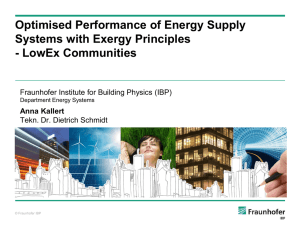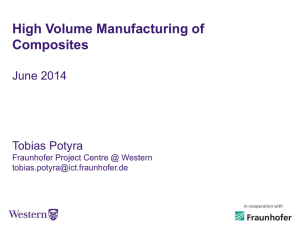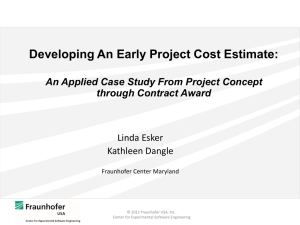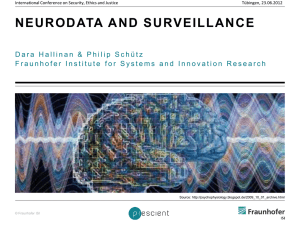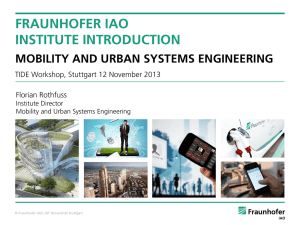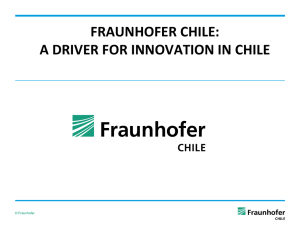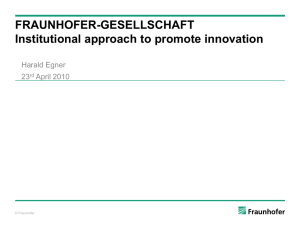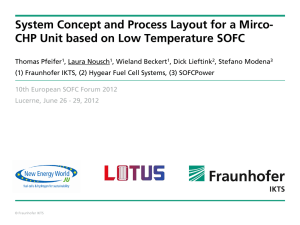4 - Modelisax
advertisement
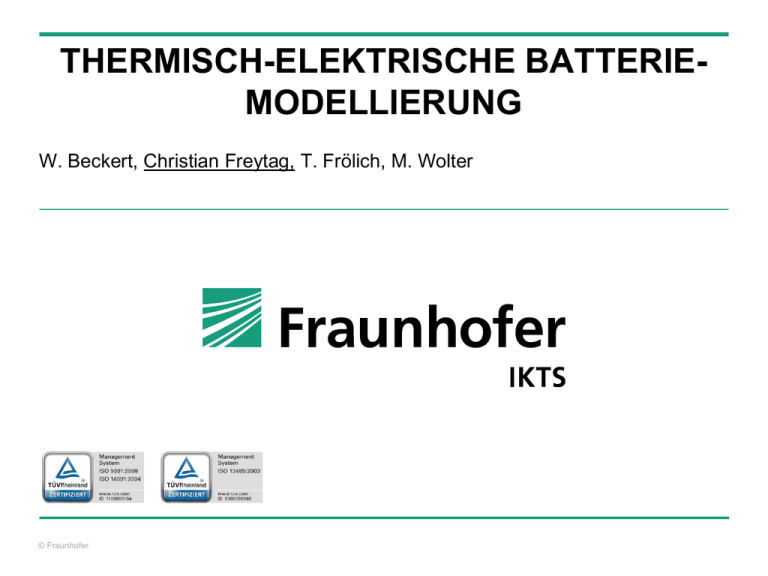
THERMISCH-ELEKTRISCHE BATTERIEMODELLIERUNG W. Beckert, Christian Freytag, T. Frölich, M. Wolter © Fraunhofer Fraunhofer Institut f. Keramische Technolog. u. Systeme Dresden Arbeitsgruppe Modellierung und Simulation: Multiphysics-Feldsimulation (FEM, CFD); Reaktive Strömung; homogenisierter Ansatz für heterogene Mesostrukturen; (Systemsimulation) Thermisches Management von Energiesystemen, ... (SOFC-Stacks + Komponenten, thermoelektrische Generatoren, Li-Ion-Batterien,...) High-Temperature-Fuel-Cell-Systems © Fraunhofer Thermo-Electric-Generator 2 Diesel-Particulate-Filter Our Model Approach for Batteries © Fraunhofer 3 Homogenisation model for winding body cell laminate current collector porous cathode separator/ electrolyte porous anode current collector isolator winding simplified 3-phase homogenised continuum approach cathode side current distributor phase combine into DOF: Uano Ucath T composite homogen. composite volume element "el.-chem." active phase: transverse charge transfer jelec huc σ eff ,cath U cath jelec huc transverse (electrolyte) current density © Fraunhofer intrins. potential anode side current distributor phase PDE: anode side charge PDE: cathode side charge Constitutive equ.: balance/ potential balance/ potential electric characteristics σ eff ,ano U ano polar. resistance jelec 4 U cath U ano U 0 T ,... RelA T , j,... PDE: thermal balance 1 λ eff T (σeff ,d jd ) jd ... d (ano, cath, elec) Model for local electrical characteristics Constitutive equation for el.-chem. active phase: intrinsic electrochemical potential Uelec U0 T , SoC R T , SoC jelec A el cell polarisation resistivity Empirical Approach: Shepherd's Model [1] [C. M. Shepherd "Theoretical design of primary and secondary cells. Part 3: battery discharge equation" NRL Report 5908; May 1963 1 1 U elec U s aT e bSoC d ' T k ' T l T jelec SoC k T SoC SoC 1 1 U 0 T , SoC RelA T , SoC © Fraunhofer 5 Introduction into SHEPHERD-Model* Discharge: Charge: * ref.: [1] © Fraunhofer 6 Introduction into SHEPHERD-Model Discharge example from SHEPHERD-Paper (NiCd-cell): 1,4 1,3 1,2 1,1 1 0,9 0,8 0 © Fraunhofer 0,2 0,4 0,6 7 0,8 1 1,2 Introduction into SHEPHERD-Model Extensions and adaptions to original SHEPHERD-Model: for OCV* for linear range only valid for isothermal and galvanostatic conditions * ref.: [2] © Fraunhofer 8 Introduction into SHEPHERD-Model LFP-6745135-30C-Cell 3,330 3,325 3,320 3,315 3,310 3,305 3,300 3,295 3,290 3,285 3,280 54,000 0,140 52,000 0,120 K/(V/A) 48,000 46,000 Vs_e _Vs_e B_e _B 44,000 270 280 290 300 310 320 0,020 270 280 290 300 310 320 260 0,036 0,100 A_e _A 300 0,032 320 320 0,01 0,00 L_e L_g -0,02 -0,03 260 270 280 290 T/K © Fraunhofer 310 0,02 -0,01 0,028 310 320 0,03 0,034 0,026 290 310 0,04 0,030 0,000 300 0,05 L/(V/A) A/V K'/V 0,150 290 0,06 K'_e _K' 0,038 0,200 280 280 T/K 0,040 270 270 T/K 0,250 260 0,060 0,000 260 T/K 0,050 0,080 0,040 42,000 260 K_e K3_ 0,100 50,000 B Vs/V Thermal-dependence of SHEPHERD-parameters: T/K 9 300 310 320 260 270 280 290 Titel 300 Introduction into SHEPHERD-Model transient battery model [3, 4, 5]: extended SHEPHERD-Modell (i≠const) non-galvanostatic part galvanostatic part(i=const) open circuit voltage (equilibrium) + transient term © Fraunhofer 10 Models and Results (Batterie Cell Level) © Fraunhofer 11 Model Geometry: Example: cylindrical cell with contact tabs (LiFePo4 , ANR 26650) separated current collector tabs, embedded between windings nonhomogeneous contacting with current concentration toward cont. tabs helical current flow + current collection 3D-model approach © Fraunhofer 12 Hybrid 2D-3D Model with Thermal Electric Coupling Concept: Combined 2D electric 3D thermal model for winding body Uano(l,y), Ucath(l,y), jelek(l,y) Qdiss(l,y) electric problem: 2D frame (unrolled electric film composite) s k s k T COMSOL: allows U 0 U 0 T integrated mapping + simultaneous cosimulation y l information transfer T Map 3D 2D Temperature T(x,y,z) Map 2D 3D Dissipation Heat thermal problem: 3D frame (thermal composite) © Fraunhofer T(x,y,z) U 0 jelec λ T Q& th (σ eff , d jd ) jd T T huc d & Q& diss Qrev 13 Hybrid-Model Results: 3D-thermal model branch Transient analysis with current pulse pattern of hot spots, induced by contacting structure temperature T C 50.2 Tloc 2.4 K dynamic analysis t= 6 s current pulse: duration 6 s Imax = 95 A = 40 C reasonable magnitude for practical operation 47.8 (LiFePo4, 26650, Ri= 10 mW) high dynamic load + small area contacts hot spot formation © Fraunhofer 14 Completion: 3D-Model with Housing Geometry/ Mesh generation winding domain: Comsol-generated add housing + contact structure: CAD-Import connecting meshs by interface elements © Fraunhofer 15 3-D Model with Housing: Results 41.9°C 40°C Temperature [°C] 35°C succesfull analysis of full cell geometry computation time: 2-6 h comparable results (hot spot formation) to winding body analysis 30°C 25°C 20°C 21.9°C 41.9°C<T<29.0°C © Fraunhofer 16 dynamic analysis I 130 A 54 C t = 6 s Models and Results (System Level) © Fraunhofer 17 Implementation in SimulationX 3.5 SimulationX 3.5 Modelica 3.2 © Fraunhofer 18 Implementation in SimulationX 3.5 7 3 4 6 5 2 1 + transient term © Fraunhofer 19 Application on External Data Sources of used data: experimental data for LFP-6745135-30C-Cell: discharge 1C, 5C, 10C including temperature data data from COMSOL build-in battery-model [6]: pulse discharge: 1C, 5C no temperature data included SHEPHERD-parameters via external data fit (Excel) © Fraunhofer 20 Application on External Data Terminal voltage from a LFP-6745135-30C-Cell 3,4 1C voltage/V 3,2 3,0 V_shep@1C 2,8 V_t@1C 2,6 V_shep@5C 2,4 V_shep@10C 5C V_t@5C 10C V_t@10C 2,2 0,0 0,1 0,2 0,3 0,4 0,5 0,6 DoD © Fraunhofer 21 0,7 0,8 0,9 1,0 1C 2,1A 5C 10,5A 10C 21A Application on External Data Temperature profile during discharge of a LFP-6745135-30C-Cell 33 31 T_Batt_1C 10C 29 T_Batt_5C T/°C 27 T_Batt_10C 25 5C 23 21 19 1C 17 15 0 500 1000 1500 2000 2500 time/s © Fraunhofer 22 3000 3500 4000 Application on External Data 1C - pulse discharge for COMSOL-Model: 4,2 voltage/V 4 3,8 peak 17,5A duty cycle 300s periode 2000s 3,6 V_shep/V 3,4 V_comsol/V 3,2 3 0 5000 10000 15000 time/s © Fraunhofer 23 20000 Application on External Data 5C - pulse discharge for COMSOL-Model: 4,2 4 3,8 voltage/V 3,6 3,4 peak 87,5A duty cycle 100s periode 2000s 3,2 3 2,8 V_shep/V 2,6 V_comsol/V 2,4 2,2 0 5000 10000 15000 time/s © Fraunhofer 24 20000 Summary T C 50.2 hybrid 2D-electric + 3D-thermal composite approach with geometrical details thermo-electric coupling homogenised 3 phase model for winding composite simple empirical model for electrical characteristics result: contact structure acts as source for thermal hot-spots in dynamic loads approach has potential for use in multi-cell models good, robust and simple model for description of terminal voltage resolution for isothermal and galvanostatic restriction of original model sufficiently accurate match between experiment and model © Fraunhofer 25 47.8 Outlook Prototype example: [IKTS] curved LTCC substrate thick-film resistor electrolyte tolerant resolution: +/- 0.6 K "Virtual Battery Thermal Lab"-Tool: analyse/ understand internal thermal processes „benchmark" for simpler models tool for cell design optimisation IKTS activity: internal cell temperature sensor assist design process optimise sensor positioning analyse effects from interference of sensor-cell implementation of charge behaviour data fit in SimulationX/Modelica coupled thermal-electric model © Fraunhofer 26 Wish List to Modelica simple data import to Modelica simple data fit function in Modelica (bidirectional) interface to FEM … © Fraunhofer 27 References [1] C. M. Shepherd: Theoretical design of primary and secondary cells part III - battery discharge equation NRL Report 5908 Washington, D.C. 1963. [2] O. Tremblay, L.-A. Dessaint, A. I. Dekkiche: A Generic Battery Model for the Dynamic Simulation of Hybrid Electric Vehicles Vehicle Power and Propulsion Conference 2007. [3] A. Jossen: Fundamentals of battery dynamics Journal of Power Sources 154 (2006) 2, S. 530–38. [4] N. Sekushin: Equivalent circuit of Warburg impedance Russian Journal of Electrochemistry 45 (2009), S. 828–32. [5] F. M. González-Longatt: Circuit Based Battery Models: A Review 2do congreso iberoamericano de estudiantes de ingenieria electrica, 2006. [6] COMSOL Multiphysics User’s Guide: Rechargeable Lithium-Ion Battery Version 3.5a, 2008. © Fraunhofer 28 Acknowledgments Fraunhofer IKTS: Georg Fauser Adrian Goldberg Diana Leiva Pinzon IAV GmbH Chemnitz: Carolus Grünig Mirko Taubenreuther Daniel Tittel This work was kindly funded by: Europäische Fond für regionale Entwicklung (EFRE) and the Freistaat Sachsen © Fraunhofer 29
